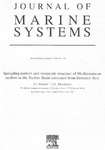Spreading pattern and mesoscale structure of Mediterranean outflow in the Iberian Basin estimated from historical data
| dc.contributor.author | Shapiro, Georgy | |
| dc.contributor.author | Meschanov, SL | |
| dc.date.accessioned | 2017-08-10T13:28:46Z | |
| dc.date.available | 2017-08-10T13:28:46Z | |
| dc.date.issued | 1996-02 | |
| dc.identifier.issn | 0924-7963 | |
| dc.identifier.uri | http://hdl.handle.net/10026.1/9740 | |
| dc.description.abstract |
The location, spreading pattern, mesoscale structure and the influence of bottom topography on the Mediterranean Water (MW) outflow were studied using historical hydrographic data from the Iberian Basin of the North Atlantic. It was shown on the basis of joint analysis of continuous and discrete component of the MW distribution, that after leaving the Gulf of Cadiz the MW outflow is broken into two main cores: Northwestern and Southwestern ones. The wide, intense Northwestern core spreads in a regular and continuous manner. West off the Tejo plateau it is split into three branches, the most intense of them keeps continuity up to 14° W. The less intense Southwestern core passes south of the Gettysburg bank and is split into two branches just after the Gulf of Cadiz. This core has a lenticular intermittent character starting with 11° W. West of 15° W all the branches of MW outflow spread in the form of isolated salty patches. In the Iberian Basin (32°-44°N, 8°-22° W) 30 MW lenses were found out, 12 of which were not mentioned in the literature before. © 1996 Elsevier Science B.V. All rights reserved. | |
| dc.format.extent | 337-348 | |
| dc.language | en | |
| dc.language.iso | en | |
| dc.publisher | Elsevier | |
| dc.title | Spreading pattern and mesoscale structure of Mediterranean outflow in the Iberian Basin estimated from historical data | |
| dc.type | journal-article | |
| dc.type | Journal Article | |
| plymouth.author-url | https://www.webofscience.com/api/gateway?GWVersion=2&SrcApp=PARTNER_APP&SrcAuth=LinksAMR&KeyUT=WOS:A1996UK93900015&DestLinkType=FullRecord&DestApp=ALL_WOS&UsrCustomerID=11bb513d99f797142bcfeffcc58ea008 | |
| plymouth.issue | 2-4 | |
| plymouth.volume | 7 | |
| plymouth.publication-status | Published | |
| plymouth.journal | Journal of Marine Systems | |
| dc.identifier.doi | 10.1016/0924-7963(95)00011-9 | |
| plymouth.organisational-group | /Plymouth | |
| plymouth.organisational-group | /Plymouth/Faculty of Science and Engineering | |
| plymouth.organisational-group | /Plymouth/PRIMaRE Publications | |
| plymouth.organisational-group | /Plymouth/REF 2021 Researchers by UoA | |
| plymouth.organisational-group | /Plymouth/REF 2021 Researchers by UoA/UoA07 Earth Systems and Environmental Sciences | |
| plymouth.organisational-group | /Plymouth/Research Groups | |
| plymouth.organisational-group | /Plymouth/Research Groups/Marine Institute | |
| plymouth.organisational-group | /Plymouth/Users by role | |
| plymouth.organisational-group | /Plymouth/Users by role/Academics | |
| plymouth.organisational-group | /Plymouth/Users by role/Researchers in ResearchFish submission | |
| dcterms.dateAccepted | 1994-12-14 | |
| dc.rights.embargoperiod | No embargo | |
| rioxxterms.versionofrecord | 10.1016/0924-7963(95)00011-9 | |
| rioxxterms.licenseref.uri | http://www.rioxx.net/licenses/all-rights-reserved | |
| rioxxterms.licenseref.startdate | 1996-02 | |
| rioxxterms.type | Journal Article/Review |


